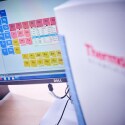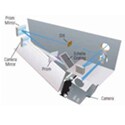Search Thermo Fisher Scientific
Inductively Coupled Plasma Optical Emission Spectroscopy (ICP-OES) Information
Inductively coupled plasma optical emission spectroscopy (ICP-OES) is the technique of choice for many different applications, including those in the environmental, metallurgical, geological, petrochemical, pharmaceutical, materials, and food safety arenas. It can be applied to varying sample types such as aqueous and organic liquids and solids. Some of these sample types need specific sample preparation techniques or the use of specific accessories.
The advantages of using ICP-OES over other elemental analysis techniques such as inductively coupled plasma mass spectrometry (ICP-MS) or atomic absorption spectrometry (AAS) include its wide linear dynamic range, high matrix tolerance, and the enhanced speed of analysis that can be achieved.
What is ICP-OES?
A plasma is a gas, in this case argon, which contains a significant number of argon ions. The plasma is formed by seeding the argon gas passing through a plasma torch with electrons. The electrons are accelerated and collide with argon atoms releasing more electrons and forming argon ions. Elements, in the form of atoms, are introduced into the plasma. A proportion of theses atoms will be become ionized within the plasma. When an atom or ion is excited within the plasma, its electrons jump from a lower to higher energy level (figure 1). Upon relaxation of these electrons to their initial 'ground' state, energy is emitted in the form of photons. The emitted photons possess wavelengths that are characteristic of their respective elements.

One element can have multiple electron excitations and relaxations; therefore, it can have multiple characteristic wavelengths. An example of an emission spectrum for calcium is shown in figure 2.
Visible emission spectrum of calcium

ICP-OES takes advantage of the unique emission spectra of elements to identify and quantify them.
In this section on ICP-OES, you will:
- Understand the systems and technologies that drive ICP-OES
- Learn which sample types can be analyzed by ICP-OES and what conditions must be considered during sample preparation and introduction
- Recognize and correct for factors that interfere with accurate data analysis
ICP-OES information subtopics
ICP-OES Sample Preparation
Learn how different sample types are prepared for ICP-OES analysis, how challenges such as spectral interference and poor sensitivity are addressed, and how samples that contain high levels of solid material are processed.
ICP-OES Data Analysis
Understand how instrument control, data processing, and analytical software coordinate ICP-OES analysis, as well as how internal standards, interference corrections and quality control protocols aid in generating accurate data.
ICP-OES Systems and Technologies
Find out more about the individual components of an ICP-OES system, how these systems are configured, and the newest developments in optical emission analysis.
Spectroscopy Elemental & Isotope Analysis Resource Library
Learn how elements and their isotopes provide information about sample origin and identity in our library of applications notes, scientific posters, webinars, and more.



